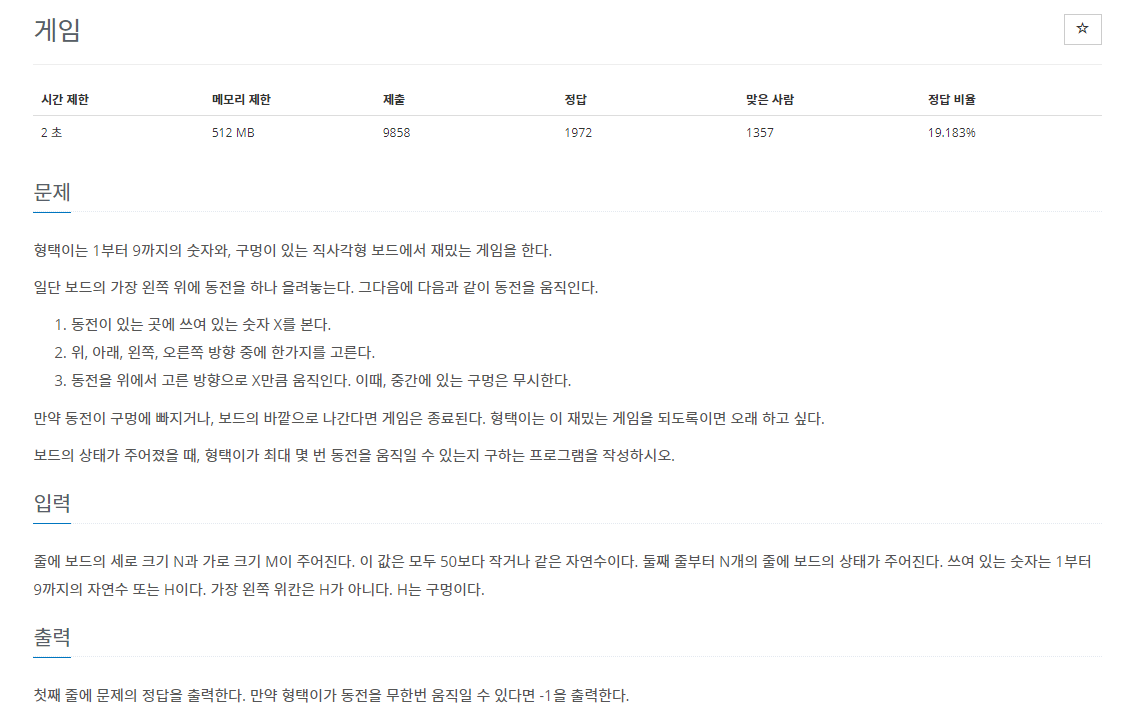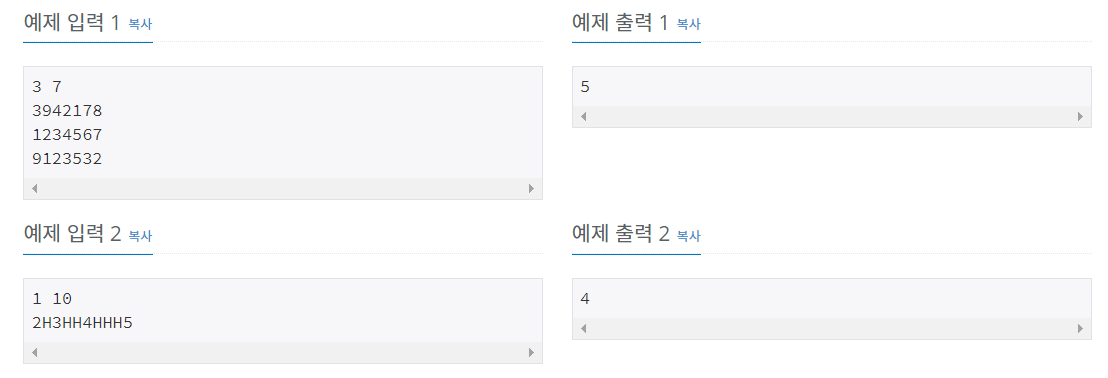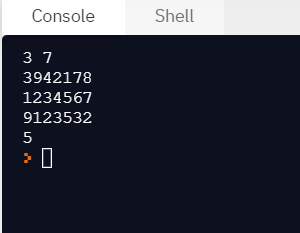백준


1. Python
import sys
sys.setrecursionlimit(10**6)
input = sys.stdin.readline
dx = [-1, 1, 0, 0]
dy = [0, 0, -1, 1]
n, m = map(int, input().split())
arr = [list(input().rstrip()) for _ in range(n)]
visited = [[False]*m for _ in range(n)]
dp = [[0]*m for _ in range(n)]
result = 0
def dfs(x, y, cnt):
global result
result = max(result, cnt)
for i in range(4):
nx = x + int(arr[x][y]) * dx[i]
ny = y + int(arr[x][y]) * dy[i]
if 0 <= nx < n and 0 <= ny < m and arr[nx][ny] != "H" and cnt + 1 > dp[nx][ny]:
if visited[nx][ny]:
print(-1)
exit()
else:
dp[nx][ny] = cnt + 1
visited[nx][ny] = True
dfs(nx, ny, cnt + 1)
visited[nx][ny] = False
dfs(0, 0, 0)
print(result + 1)

2. C++
#include <iostream>
using namespace std;
#include <stdio.h>
#include <stdlib.h>
#include <string.h>
int N, M;
char map[52][52];
bool visited[52][52];
int dp[52][52];
int dy[4] = {-1, 0, 1, 0};
int dx[4] = {0, -1, 0, 1};
int solve(int y, int x){
if(y < 1 || y > N || x < 1 || x > M || map[y][x] == 'H'){
return 0;
}
if(visited[y][x] == true){
printf("-1\n");
exit(0);
}
if(dp[y][x] != -1){
return dp[y][x];
}
dp[y][x] = 0;
visited[y][x] = true;
int step = map[y][x]-'0';
for(int i=0; i<4; ++i){
int ny = y + (dy[i] * step);
int nx = x + (dx[i] * step);
dp[y][x] = max(dp[y][x], solve(ny, nx)+1);
}
int main(){
memset(visited, false, sizeof(visited));
memset(dp, -1, sizeof(dp));
scanf("%d%d", &N, &M);
for(int i=1; i<=N; ++i){
char str[52];
scanf("%s", str);
for(int j=1; j<=M; ++j){
map[i][j] = str[j-1];
}
}
int result = solve(1, 1);
printf("%d\n", result);
return 0;
}
#include <cstdio>
int n, m, ans, dy[] = {-1, 1, 0, 0}, dx[] = {0, 0, -1, 1}, limit;
int max_count[50][50];
char board[50][51];
void dfs(int y, int x, int cnt) {
if (ans < cnt) ans = cnt;
if (ans > limit) return;
if (y < 0 || n <= y || x < 0 || m <= x || board[y][x] == -1) return;
if (cnt <= max_count[y][x]) return;
max_count[y][x] = cnt;
int mul = board[y][x];
for (int i = 0 ; i < 4 ; i++) {
dfs(y + dy[i] * mul, x + dx[i] * mul, cnt + 1);
}
}
int main() {
scanf("%d%d", &n, &m);
limit = n * m;
for (int i = 0 ; i < n ; i++) {
for (int j = 0 ; j < m ; j++) {
max_count[i][j] = -1;
}
}
for (int i = 0 ; i < n ; i++) {
scanf("%s", board[i]);
for (int j = 0 ; j < m ; j++) {
if (board[i][j] == 'H') board[i][j] = -1;
else board[i][j] -= '0';
}
}
dfs(0, 0, 0);
if (ans > limit) ans = -1;
printf("%d", ans);
}




